Westfield-Barnes Regional Airport (BAF)
Westfield-Barnes Regional Airport (BAF) is one of Massachusetts' largest airports with a strong flight training, general aviation, and military presence. It is also known as Barnes Air National Guard Base. With a 9000’ runway, BAF is able to accommodate numerous aircraft types. BAF is located three miles north of the city of Westfield in Hampden County, MA. View a printable Pilot Handbook of the BAF information.
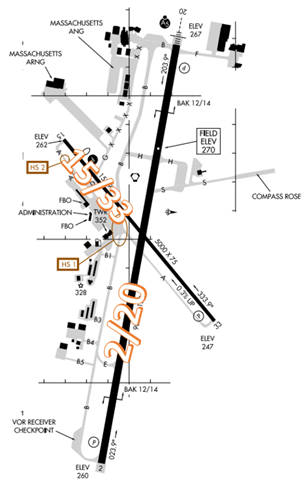
Know Before You Go
KBAF Tower Hours of Operation 0700L-2200L
Administrative Office Open 0800L to 1600L M-F
Business Phone 413-562-4582
The airport configuration consists of intersecting RWYs 2/20 and 15/33.
The airspace at BAF is Class D. (Refer to Sectional Chart)
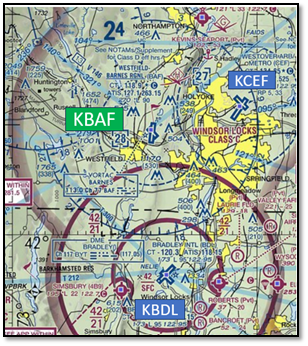
Hot Spots
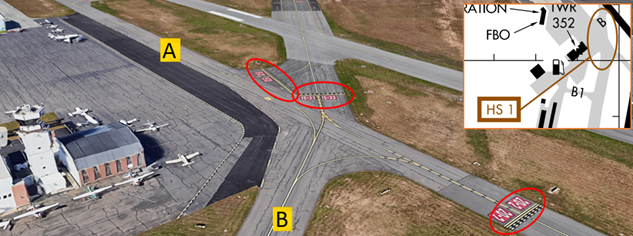
HS 1 Maintain vigilance departing the ramp. TWY A and TWY B complex intersection in close proximity runways.
- Pilots should review the taxi clearance before starting to taxi. Actively scanning to locate and identify RWY signs, markings, and lighting and deferring all heads down activities until holding short at the appropriate location will help eliminate these errors.
HS 2 Unusual location for runway hold position markings on TWY A for RWY 15.
- The RWY Hold Short Markings for RWY 15 on TWY A are located farther from the approach end of the RWY than a pilot may expect.
- Pilots taxiing to RWY 15 may miss the hold short line resulting in a runway incursion.
- If you are ever unsure of your clearance or position, ask the TWR.
- View the From the Flight Deck - Complex Airfield Geometry#7: Hold Short Lines in Unexpected Places for additional information.
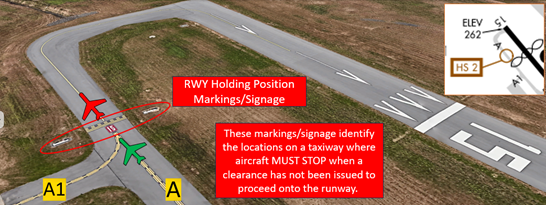
Surface Risk - Movement Area Cautions
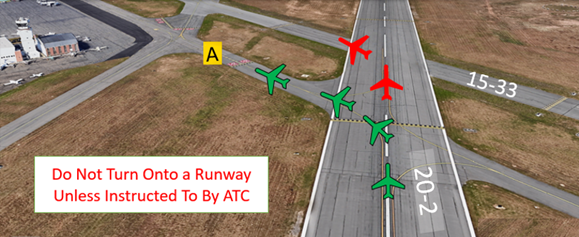
- Pilots landing RWY 2 instructed to turn left on TWY A have missed TWY A and turned onto RWY 15/33.
- Pilots should thoroughly review expected taxi routes and the overall airport configuration prior to arrival. If you are ever unsure of your instructions or your position, ask the TWR.
- At BAF, or any airport, pilots must be aware that an intersection departure presents the risk of taking off in the wrong direction. Pilots have attempted to turn in the wrong direction when issued takeoff clearance.
- The example illustration below depicts a commonly utilized intersection, RWY 2/20 at TWY A.
- Prior to entering the RWY and again when lining up on the RWY, check your Magnetic Compass and, your Horizontal Situation Indicator (HSI), if installed, to verify that you are pointed in the correct direction.
- View the From the Flight Deck-Wrong Direction Intersection Takeoffs video for more information and mitigation strategies.
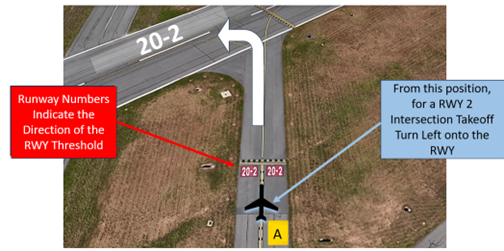
General
- Westfield Airport has a very diverse group of users. The airport is home to the Massachusetts ANG 104th Fighter Wing (F-15/F-35) and MA ARNG Support Facility (UH-60/EC-45). Additionally, flight schools, aircraft maintenance and a modern terminal draw a wide array of aircraft and experience levels.
Traffic Patterns
- Pilots should be prepared to fly both left and right patterns. Considering the proximity to other airports, airspace restrictions and blending of helicopters, jets and general aviation aircraft along with the airport environment, ATC will determine your pattern upon arrival/departure.
Ground Control
- If flight following services are desired from approach control, make your request on initial contact, including callsign, type of aircraft, destination and requested VFR altitude.
- Acknowledge all hold short instructions with your callsign.
- Always follow painted lead-in lines to avoid encroachment on intersecting runway safety areas. Please request progressive taxi instructions if unfamiliar.
Arrival/Landing
- General aviation aircraft arriving/departing BAF should not track the extended centerlines of RWY 2/20 without ATC approval. IFR aircraft predominantly utilize RWY 2/20. Additionally, F15/F35 scrambles can occur at any time.
- Yankee Approach provides IFR separation, to the extent possible, to VFR aircraft executing practice instrument approaches.
- Pilots should review NOTAMS for the Letter to Airmen LTA-Y90-22 “Practice Instrument Approaches” for specific information.
Takeoff/Departure
- Departures should be alert for intersection departure instructions.
- Runups should be completed short of the departure runway and not on the terminal ramp.
Additional Information
- Severe downdraft at approach end RWY 33 when wind NW in excess of 15 kts.
- Birds and wildlife on and in the vicinity of the airport.
- RWY 2/20 has arresting barriers. Small aircraft should use caution especially at night and if possible, confirm the actual status of the barriers prior to landing.
